制造型企业运作管理英文版)
- 格式:ppt
- 大小:895.50 KB
- 文档页数:14

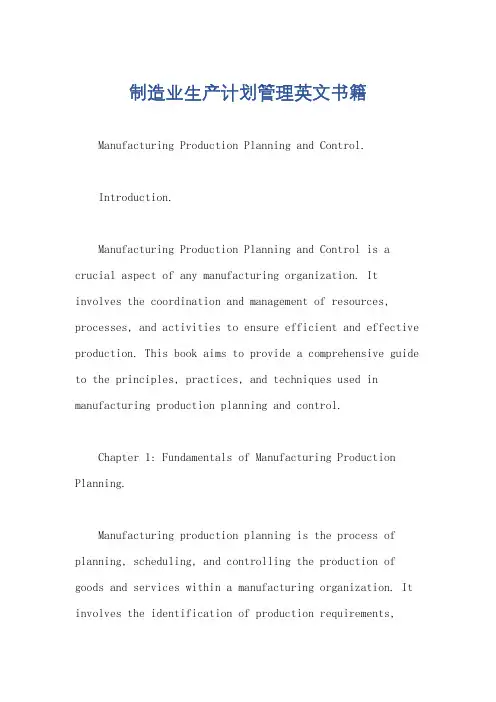
制造业生产计划管理英文书籍Manufacturing Production Planning and Control.Introduction.Manufacturing Production Planning and Control is a crucial aspect of any manufacturing organization. It involves the coordination and management of resources, processes, and activities to ensure efficient and effective production. This book aims to provide a comprehensive guide to the principles, practices, and techniques used in manufacturing production planning and control.Chapter 1: Fundamentals of Manufacturing Production Planning.Manufacturing production planning is the process of planning, scheduling, and controlling the production of goods and services within a manufacturing organization. It involves the identification of production requirements,determination of the optimal production mix, allocation of resources, and monitoring and controlling the production process.The first step in manufacturing production planning is the identification of production requirements. This involves understanding the demand for products or services and translating it into production requirements. Production requirements can be derived from various sources such as customer orders, forecasted demand, and inventory levels.Once the production requirements are identified, the next step is to determine the optimal production mix. This involves deciding which products or services to produce, in what quantities, and when to produce them. The production mix should be optimized to maximize profitability, minimize costs, and meet customer demand.The allocation of resources is another crucial step in manufacturing production planning. Resources such as raw materials, equipment, labor, and capital need to be allocated efficiently to ensure smooth production. Resourceallocation should take into account the availability of resources, production requirements, and the capacity of the production system.Monitoring and controlling the production process is essential to ensure that production plans are being executed effectively. This involves tracking production performance, identifying bottlenecks and issues, and taking corrective actions to ensure that production remains on track.Chapter 2: Production Scheduling.Production scheduling is the process of developing a detailed plan for the production of goods and services based on the identified production requirements. It involves scheduling production activities, allocating resources, and ensuring that production deadlines are met.There are various types of production scheduling methods, including forward scheduling, backward scheduling, and constraint-based scheduling. Forward schedulinginvolves starting with the first available production slot and scheduling activities forward in time. Backward scheduling, on the other hand, starts with the final production deadline and schedules activities backward in time. Constraint-based scheduling focuses on identifying and managing the constraints that limit production capacity and scheduling activities around these constraints.Effective production scheduling requires the use of advanced planning and scheduling tools. These tools help manufacturers to analyze production requirements, identify bottlenecks, optimize resource allocation, and generate detailed production schedules.Chapter 3: Production Control.Production control is the process of monitoring and controlling the production process to ensure that production plans are being executed effectively. It involves tracking production performance, identifying bottlenecks and issues, and taking corrective actions to ensure that production remains on track.Production control systems are used to monitor and control the production process. These systems collect real-time data on production activities, analyze performance, and generate reports and alerts when issues arise. Manufacturers can use this information to identify bottlenecks, optimize production processes, and take corrective actions to improve production efficiency.In addition to production control systems, manufacturers also need to consider quality control and lean manufacturing principles. Quality control involves ensuring that products meet specified quality standards and customer requirements. Lean manufacturing, on the other hand, focuses on eliminating waste and improving production efficiency through continuous improvement and process optimization.Conclusion.Manufacturing Production Planning and Control is a critical aspect of any manufacturing organization. Itinvolves the coordination and management of resources, processes, and activities to ensure efficient and effective production. By understanding the fundamentals of manufacturing production planning, using advanced planning and scheduling tools, and implementing effective production control systems, manufacturers can optimize production processes, improve production efficiency, and meet customer demand.。
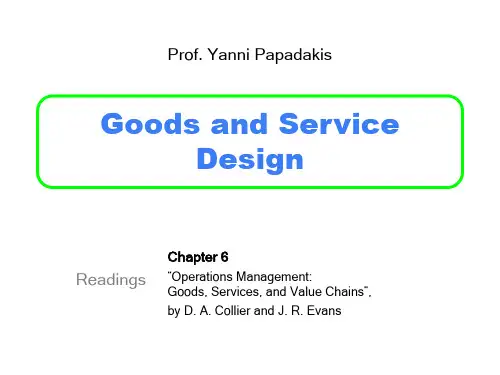
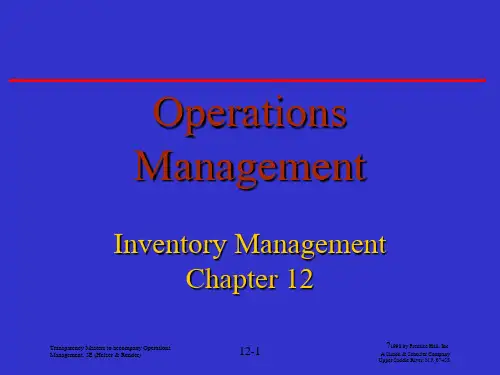

企业运营管理英语作文Operational Management in Businesses。
When it comes to business operations, it's all about getting the right people to do the right things at theright time. You know, like a symphony orchestra — everyone has their part, and they all need to play it perfectly to create harmony.But let's face it, running a business isn't all about music and roses. It's about dealing with challenges and unexpected curveballs. That's where a solid operational plan comes in. It's like a roadmap that guides you through the twists and turns, keeping you on track.And then there's the team. They're the heart and soul of any business. You need to motivate them, inspire them, and keep them engaged. After all, they're the ones executing the plan and bringing it to life. A little appreciation and recognition can go a long way.Of course, you can't talk about operational management without mentioning technology. It's revolutionized the way we do business. From automating mundane tasks to analyzing data, technology has made operations more efficient and effective.Lastly, flexibility is key. Things change, and you need to be able to adapt quickly. Whether it's a new market trend or a sudden crisis, being nimble allows you to pivot and seize new opportunities. After all, in business, as in life, it's not about where you start, it's about where you end up.。
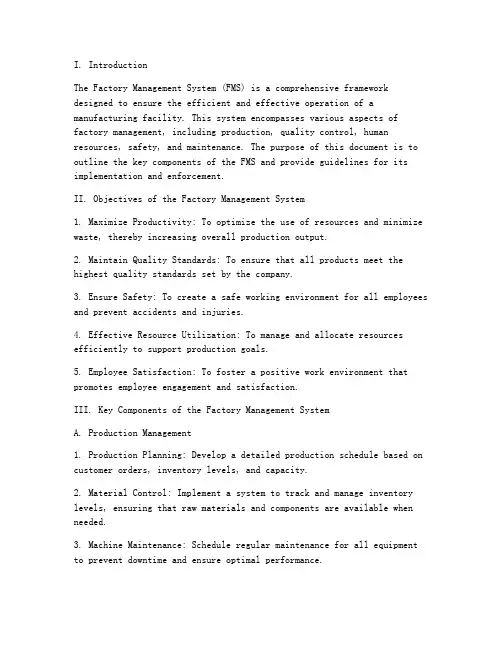
I. IntroductionThe Factory Management System (FMS) is a comprehensive framework designed to ensure the efficient and effective operation of a manufacturing facility. This system encompasses various aspects of factory management, including production, quality control, human resources, safety, and maintenance. The purpose of this document is to outline the key components of the FMS and provide guidelines for its implementation and enforcement.II. Objectives of the Factory Management System1. Maximize Productivity: To optimize the use of resources and minimize waste, thereby increasing overall production output.2. Maintain Quality Standards: To ensure that all products meet the highest quality standards set by the company.3. Ensure Safety: To create a safe working environment for all employees and prevent accidents and injuries.4. Effective Resource Utilization: To manage and allocate resources efficiently to support production goals.5. Employee Satisfaction: To foster a positive work environment that promotes employee engagement and satisfaction.III. Key Components of the Factory Management SystemA. Production Management1. Production Planning: Develop a detailed production schedule based on customer orders, inventory levels, and capacity.2. Material Control: Implement a system to track and manage inventory levels, ensuring that raw materials and components are available when needed.3. Machine Maintenance: Schedule regular maintenance for all equipment to prevent downtime and ensure optimal performance.4. Quality Control: Establish a quality control process to inspect products at various stages of production to ensure compliance withquality standards.B. Quality Control1. Inspection Procedures: Define specific inspection procedures for raw materials, work-in-progress, and finished goods.2. Non-Conformance Management: Establish procedures for handling non-conforming products, including root cause analysis and corrective actions.3. Continuous Improvement: Encourage employees to identify and implement improvements in the production process.4. Certification: Obtain relevant quality certifications (e.g., ISO 9001) to demonstrate compliance with international standards.C. Human Resources Management1. Recruitment and Selection: Develop a recruitment process thatattracts and selects qualified candidates for all positions.2. Training and Development: Provide ongoing training and development opportunities to enhance employee skills and knowledge.3. Performance Management: Implement a performance management system to evaluate employee performance and provide feedback.4. Employee Engagement: Foster a culture of open communication and employee involvement in decision-making processes.D. Safety Management1. Safety Policies: Develop and implement comprehensive safety policies that cover all aspects of workplace safety.2. Safety Training: Provide regular safety training for all employees to ensure they are aware of potential hazards and how to mitigate them.3. Emergency Preparedness: Establish emergency response procedures for various scenarios, including fire, medical emergencies, and natural disasters.4. Inspections and Audits: Conduct regular safety inspections and audits to identify and address potential hazards.E. Maintenance Management1. Preventive Maintenance: Implement a preventive maintenance program to schedule regular maintenance activities for all equipment.2. Predictive Maintenance: Utilize predictive maintenance techniques to identify potential equipment failures before they occur.3. spare Parts Management: Maintain an inventory of spare parts to ensure that replacements are available when needed.4. Maintenance Records: Keep detailed records of all maintenance activities to monitor equipment performance and identify trends.IV. Implementation and EnforcementA. Implementation1. Communication: Ensure that all employees are aware of the FMS and understand their roles and responsibilities.2. Training: Provide training sessions for all employees to familiarize them with the various components of the FMS.3. Documentation: Develop comprehensive documentation that outlines the FMS and provides guidance for its implementation.4. Technology: Utilize appropriate technology (e.g., ERP systems, CMMS) to support the FMS and streamline operations.B. Enforcement1. Monitoring: Regularly monitor the implementation of the FMS to ensure compliance with established policies and procedures.2. Reporting: Establish a reporting system for employees to report any issues or concerns related to the FMS.3. Audit: Conduct periodic audits to assess the effectiveness of the FMS and identify areas for improvement.4. Rewards and Consequences: Implement a system of rewards for employees who contribute to the success of the FMS and consequences for those who do not comply with established policies.V. ConclusionThe Factory Management System is a crucial tool for ensuring the success of a manufacturing facility. By focusing on productivity, quality, safety, and employee satisfaction, the FMS can help organizations achieve their goals and maintain a competitive edge in the marketplace. By implementing and enforcing the FMS, companies can create a more efficient, effective, and sustainable production environment.。
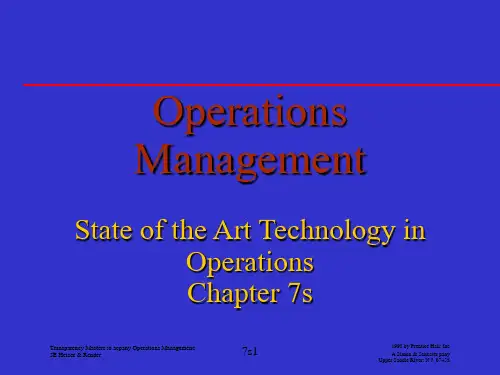
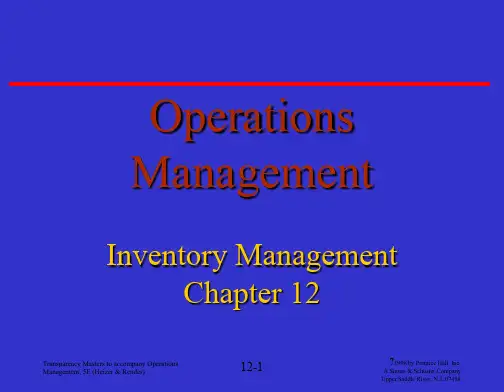

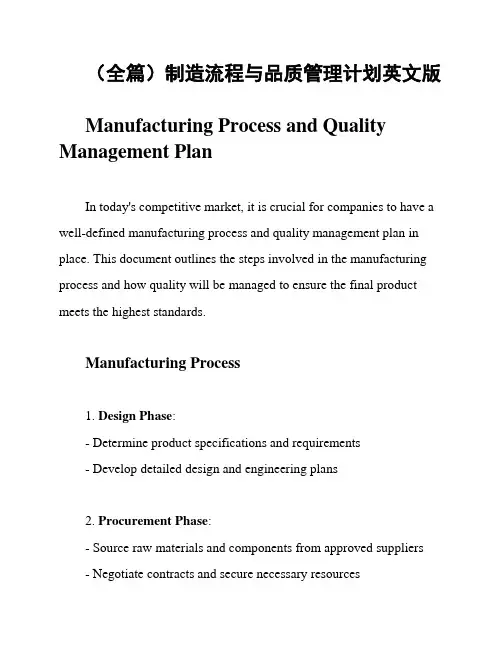
(全篇)制造流程与品质管理计划英文版Manufacturing Process and Quality Management PlanIn today's competitive market, it is crucial for companies to have a well-defined manufacturing process and quality management plan in place. This document outlines the steps involved in the manufacturing process and how quality will be managed to ensure the final product meets the highest standards.Manufacturing Process1. Design Phase:- Determine product specifications and requirements- Develop detailed design and engineering plans2. Procurement Phase:- Source raw materials and components from approved suppliers- Negotiate contracts and secure necessary resources3. Production Phase:- Assemble components according to design plans- Test prototypes for quality assurance4. Quality Control Phase:- Implement quality control measures at each stage of production - Conduct inspections and tests to identify defects5. Packaging and Shipping Phase:- Package finished products securely- Arrange for shipping to distribution centers or customersQuality Management Plan1. Quality Standards:- Adhere to industry-specific quality standards and regulations- Establish internal quality control measures to meet or exceed standards2. Quality Assurance:- Implement quality assurance processes to prevent defects- Conduct regular audits to ensure compliance with quality standards3. Training and Development:- Provide training to employees on quality control procedures- Encourage continuous improvement through feedback and training programs4. Supplier Management:- Evaluate suppliers based on quality of products and services- Establish partnerships with reliable suppliers to ensure consistent quality5. Customer Feedback:- Collect feedback from customers to identify areas for improvement- Use customer feedback to make necessary adjustments to the manufacturing process6. Continuous Improvement:- Implement a system for monitoring and measuring quality metrics - Identify opportunities for improvement and make necessary changesBy following this manufacturing process and quality management plan, we aim to produce high-quality products that meet customer expectations and maintain a competitive edge in the market.。
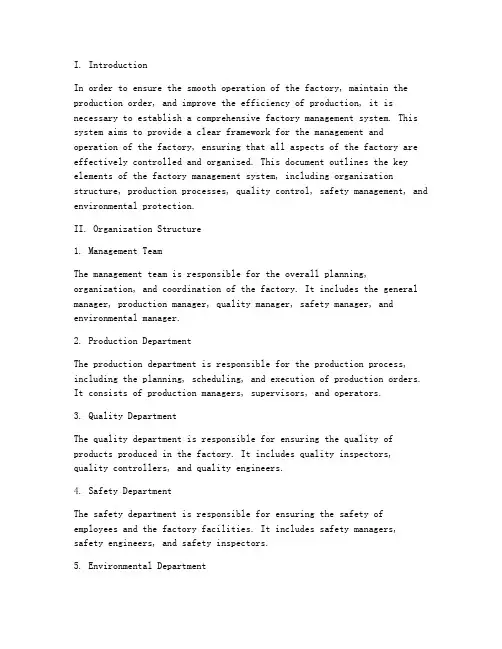
I. IntroductionIn order to ensure the smooth operation of the factory, maintain the production order, and improve the efficiency of production, it is necessary to establish a comprehensive factory management system. This system aims to provide a clear framework for the management and operation of the factory, ensuring that all aspects of the factory are effectively controlled and organized. This document outlines the key elements of the factory management system, including organization structure, production processes, quality control, safety management, and environmental protection.II. Organization Structure1. Management TeamThe management team is responsible for the overall planning, organization, and coordination of the factory. It includes the general manager, production manager, quality manager, safety manager, and environmental manager.2. Production DepartmentThe production department is responsible for the production process, including the planning, scheduling, and execution of production orders. It consists of production managers, supervisors, and operators.3. Quality DepartmentThe quality department is responsible for ensuring the quality of products produced in the factory. It includes quality inspectors,quality controllers, and quality engineers.4. Safety DepartmentThe safety department is responsible for ensuring the safety of employees and the factory facilities. It includes safety managers, safety engineers, and safety inspectors.5. Environmental DepartmentThe environmental department is responsible for environmental protection and compliance with relevant regulations. It includes environmental managers, environmental engineers, and environmental inspectors.III. Production Processes1. Production PlanningThe production department is responsible for the planning of production schedules based on customer orders, inventory levels, and production capacity. The planning process includes the determination of production priorities, resource allocation, and production deadlines.2. Production SchedulingOnce the production plan is established, the production department will schedule the production activities accordingly. This includes assigning tasks to production teams, determining the sequence of operations, and setting production targets.3. Production ExecutionThe production department will ensure that production activities are carried out as per the schedule. Operators will follow the standard operating procedures (SOPs) to ensure consistent and high-quality production.4. Production ControlDuring the production process, the production department will monitor and control the production activities to ensure the quality, efficiency, and safety of the products. Any deviations from the SOPs or production targets will be immediately addressed.IV. Quality Control1. Incoming Materials InspectionThe quality department will inspect incoming materials to ensure they meet the required specifications and quality standards. Any defective materials will be rejected and reported to the supplier.2. In-process Quality ControlThroughout the production process, the quality department will conduct in-process inspections to ensure that the products are in compliance with the quality requirements. Any defects or deviations will be corrected immediately.3. Final Product InspectionBefore the products are dispatched, the quality department will conduct a final product inspection to ensure that they meet the required quality standards. Only products that pass the inspection will be released for shipment.V. Safety Management1. Safety Policies and ProceduresThe safety department will establish safety policies and procedures to ensure the safety of employees and the factory facilities. Thesepolicies will cover all aspects of safety, including workplace safety, machinery safety, and emergency response.2. Safety Training and EducationThe safety department will conduct regular safety training and education programs for employees to enhance their safety awareness and knowledge. All employees are required to attend these programs and pass the safety assessments.3. Safety Inspections and AuditsThe safety department will conduct regular safety inspections and audits to identify potential hazards and ensure compliance with safety regulations. Any safety issues will be addressed immediately to prevent accidents and injuries.VI. Environmental Protection1. Environmental Policies and RegulationsThe environmental department will establish environmental policies and procedures to ensure compliance with relevant environmental regulations and standards. These policies will cover waste management, energy conservation, and pollution control.2. Waste ManagementThe environmental department will implement effective waste management practices to minimize the impact on the environment. This includes the proper disposal of hazardous waste, recycling of materials, and reduction of waste generation.3. Energy ConservationThe environmental department will promote energy conservation measures to reduce energy consumption and lower the carbon footprint of the factory. This includes the use of energy-efficient equipment, optimization of production processes, and employee engagement in energy-saving activities.VII. ConclusionThe establishment of a comprehensive factory management system iscrucial for ensuring the smooth operation of the factory, maintaining production order, and improving the efficiency of production. By implementing the key elements outlined in this document, the factory can achieve its production goals while ensuring the safety, quality, and environmental sustainability of its operations.。
IntroductionThe Factory Management System (FMS) is designed to ensure the efficient and effective operation of the factory. This system encompasses various aspects of factory management, including production planning, quality control, inventory management, human resource management, safety and health, and environmental protection. The following document outlinesthe key components of the FMS, ensuring compliance with regulatory standards and promoting a safe and productive work environment.I. Production Planning1. Master Production Schedule (MPS): The MPS will be developed based on customer orders, sales forecasts, and inventory levels. It will outline the production requirements for each product, including quantities and timelines.2. Bill of Materials (BOM): A detailed list of all materials, components, and sub-assemblies required to manufacture a product. The BOM will be used to track inventory levels and ensure the availability of necessary materials.3. Work Scheduling: Production schedules will be created to allocate resources efficiently, including labor, machinery, and raw materials. Schedules will be adjusted as needed to accommodate changes in demand or production issues.II. Quality Control1. Quality Assurance (QA) Plan: A comprehensive plan outlining thequality objectives, processes, and procedures to ensure the productionof high-quality products.2. Inspection and Testing: Regular inspections and testing will be conducted at various stages of the production process to identify and rectify any defects or deviations from quality standards.3. Non-Conforming Product Handling: Any non-conforming products will be identified, isolated, and analyzed to determine the root cause of the issue. Corrective actions will be implemented to prevent recurrence.III. Inventory Management1. Inventory Tracking: An inventory management system will be implemented to track the movement of materials, components, and finished goods. This will ensure accurate inventory levels and prevent stockouts or overstocking.2. Reorder Points: Reorder points will be established based on lead time, usage rate, and desired safety stock levels to maintain optimalinventory levels.3. Supplier Management: Suppliers will be evaluated and selected basedon quality, reliability, and cost. Regular supplier performance reviews will be conducted to ensure ongoing quality and service levels.IV. Human Resource Management1. Employee Training: Regular training programs will be conducted to ensure employees are proficient in their respective roles and understand the company’s quality standards and safety procedures.2. Performance Management: A performance management system will be established to monitor and evaluate employee performance against established goals and objectives.3. Employee Relations: A positive work environment will be fostered through open communication, fair treatment, and recognition of employee contributions.V. Safety and Health1. Safety Policies: Comprehensive safety policies will be implementedand communicated to all employees. These policies will cover workplace safety, emergency procedures, and the use of personal protective equipment (PPE).2. Safety Inspections: Regular safety inspections will be conducted to identify and address potential hazards. Any safety issues will berectified immediately to prevent accidents and injuries.3. Health and Wellness: A health and wellness program will be established to promote the physical and mental well-being of employees. This may include access to medical services, fitness facilities, and stress management resources.VI. Environmental Protection1. Environmental Policy: An environmental policy will be developed to minimize the environmental impact of factory operations. This policywill be in line with local and international environmental regulations.2. Waste Management: A waste management system will be implemented to handle and dispose of hazardous and non-hazardous waste in an environmentally responsible manner.3. Energy Efficiency: Measures will be taken to improve energyefficiency in the factory, including the use of energy-efficient equipment, regular maintenance, and employee awareness programs.VII. Compliance and Auditing1. Regulatory Compliance: The factory will comply with all applicable local, national, and international regulations and standards, including health and safety, environmental protection, and labor laws.2. Internal Audits: Regular internal audits will be conducted to ensure compliance with the FMS and identify areas for improvement.3. External Audits: External audits may be conducted by regulatory authorities or certification bodies to verify compliance with relevant standards.ConclusionThe Factory Management System is a comprehensive framework designed to ensure the smooth and efficient operation of the factory. By adhering to the guidelines outlined in this document, the factory can maintain high-quality standards, optimize resource allocation, ensure safety and health, and protect the environment. The continuous improvement of theFMS will be a priority to enhance the overall performance and sustainability of the factory.工厂管理制度引言工厂管理制度(FMS)旨在确保工厂的高效和有效运营。
生产与运作管理英语Production and Operations Management.Production and operations management (POM) is a crucial discipline within the realm of business administration, dealing with the planning, organization, control, and improvement of production and manufacturing processes. It encompasses various activities such as production planning, inventory management, supply chain management, quality control, and facility planning. POM aims to maximize efficiency, reduce costs, and ensure the timely delivery of quality products or services to customers.The importance of POM cannot be overstated, as it is the backbone of any manufacturing or service-oriented business. Effective POM ensures that resources are allocated efficiently, production schedules are met, and quality standards are maintained. This, in turn, contributes to overall business profitability and customer satisfaction.One of the key functions of POM is production planning, which involves determining the optimal mix of products or services to be produced, the quantity to be produced, and the timeframes within which they should be completed. This planning process takes into account various factors such as demand forecasts, capacity constraints, raw material availability, and technological capabilities. By carefully balancing these factors, POM professionals aim to maximize production output while minimizing waste and downtime.Inventory management is another crucial aspect of POM. It involves the decision-making process related to the ordering, storing, and movement of inventory. Effective inventory management ensures that raw materials andfinished goods are available when needed, minimizing the risk of stockouts or overstocking. This, in turn, helps to maintain a healthy cash flow and reduce carrying costs associated with inventory.Supply chain management is a crucial component of POM, dealing with the integration of suppliers, manufacturers,distributors, and customers into a coherent network. POM professionals are responsible for managing the flow of goods and information throughout the supply chain, ensuring that raw materials are obtained in a timely and cost-effective manner, and that finished products are delivered to customers efficiently.Quality control is an integral part of POM, focusing on ensuring that products or services meet specified quality standards. POM professionals use various tools and techniques, such as statistical process control and quality assurance audits, to monitor and improve the quality of production processes. By identifying and addressing issues early on, POM helps to prevent costly quality failures and enhances customer satisfaction.Facility planning is another important aspect of POM, dealing with the design, layout, and maintenance of production facilities. POM professionals are responsiblefor ensuring that facilities are designed efficiently, allowing for maximum productivity and minimum waste. They also ensure that facilities are maintained properly,minimizing downtime and ensuring the safety of employees.In conclusion, production and operations management is a vital discipline that plays a crucial role in the success of manufacturing and service-oriented businesses. By effectively managing production processes, inventory, supply chains, quality, and facilities, POM professionals contribute to the profitability, efficiency, and customer satisfaction of their organizations. As businesses continue to evolve and face new challenges, the role of POM will become increasingly important in ensuring competitive advantage and sustainable growth.。
2024年某汽车零部件制造商管理体系及岗位职责英文版Document Title: Management System and Job Responsibilities of a Certain Automotive Parts Manufacturer in 2024In the year 2024, the management system and job responsibilities of a particular automotive parts manufacturer are crucial for the smooth operation of the company. This document outlines the key aspects of the management system and the various job roles within the organization.Management SystemThe management system of the automotive parts manufacturer in 2024 focuses on efficiency, quality, and innovation. It involves a hierarchical structure with clear lines of authority and responsibility. The top management sets the strategic direction, while middle management oversees day-to-day operations and ensures that objectives are met. The lower-level employees carry out the tasks assigned to them and contribute to the overall success of the company.Job Responsibilities1. Top Management- Develop strategic plans and objectives for the company- Monitor the overall performance and financial health of the organization- Make important decisions related to investments, expansion, and market positioning2. Middle Management- Implement the strategies set by the top management- Coordinate the activities of different departments within the company- Ensure that production targets are met and quality standards are maintained3. Production Department- Manufacture automotive parts according to specifications- Ensure that production processes are efficient and cost-effective - Implement quality control measures to prevent defects4. Quality Assurance Department- Inspect and test automotive parts to ensure they meet quality standards- Develop and implement quality control processes- Address any issues related to product quality and safety5. Supply Chain Management- Manage the procurement of raw materials and components- Ensure timely delivery of parts to the production line- Optimize the supply chain to reduce costs and improve efficiency6. Human Resources Department- Recruit, train, and develop employees- Manage employee relations and performance evaluations- Implement policies related to compensation, benefits, and workplace safety7. Research and Development- Conduct research on new technologies and materials- Develop innovative designs for automotive parts- Collaborate with other departments to bring new products to marketIn conclusion, the management system and job responsibilities of the automotive parts manufacturer in 2024 are essential for achieving the company's goals and staying competitive in the industry. Each department plays a crucial role in ensuring the smooth operation of the organization and the delivery of high-quality products to customers.。
ManufactureEnglish制造型企业英语制造业常用英语词汇--强烈推荐总经理办公室General manager’s office 模具部T ooling department项目部Project department品质部Quality department计划部Plan department制造部Manufacture departmentKeypad产品部Keypad departmentIMD 产品部IMD department五金部Metal stamping department设计科Design section冲压车间Stamping workshop电镀车间Plating workshop物控科Production material control section 计划科Plan section仓务科Warehouse section商务科Business section品质规划科quality plan sectionIQC科IQC sectionIPQC科IPQC sectionOQC科OQC section检测中心measurement center项目规划科Project plan section项目XX科Project section XX试模科Mold test section成本科Cost section设备科Facility section采购科Purchase section综合办General affairs office编程科Programming section模具工程科T ooling engineering section模具装配车间Mold assembly workshop文控中心Document control center (DCC) 注塑车间Injection workshop喷涂车间Spray painting workshop装配车间Assembly workshop总经理General manager (GM)经理managerXX部门经理Manager of XX department 原料库Raw material warehouse半成品库Semi-finished product warehouse 成品库Finished product warehouse科长section chief主任chief部门主管department head主管, 线长supervisor组长Foreman, forelady秘书secretary文员clerk操作员operator助理assistant职员staff二、产品超声波焊接ultrasonic welding塑胶件Plastic parts塑材Raw parts喷涂件Painted parts装配件Assembly parts零件Component原料Raw material油漆Paint稀释剂Thinner油墨Ink物料编号part number三、模具注塑模具injection mold冲压模具Stamping tool模架mold base定模座板Fixed clamp plate A板A plateB板B plate支承板support plate方铁spacer plate回位销Return pin导柱Guide pin动模座板Moving clamp plate 顶针ejector pin单腔模具single cavity mold 多腔模具multi-cavity mold 浇口gate合模力clamping force锁模力locking force开裂crack循环时间cycle time老化aging螺杆screw镶件Insert主流道sprue分流道runner浇口gate直浇口direct gate点浇口pin-point gate测浇口edge gate潜伏浇口submarine gate浇口套sprue bush流道板runner plate排气槽vent分型线(面)parting line定模Fixed mold动模movable mold型腔cavity凹模cavity plate,凸模core plate斜销angle pin滑块slide拉料杆sprue puller定位环locating ring脱模斜度draft滑动型芯slide core螺纹型芯threaded core热流道模具hot-runner mold熔合纹weld line三板式模具three plate mold脱模ejection脱模剂release agent注射能力shot capacity注射速率injection rate注射压力injection pressure保压时间holding time闭模时间closing time电加工设备Electron Discharge Machining数控加工中心CNC machine center万能铁床Universal milling machine平面磨床Surface grinding machine万能摇臂钻床Universal radial movable driller 立式钻床Vertical driller倒角chamfer键Key键槽keyway间距pitch快速成型模Rapid prototype tool (RPT)四、品管SPC statistic process control品质保证Quality Assurance(QA)品质控制Quality control(QC)来料检验IQC Incoming quality control巡检IPQC In-process quality control校对calibration环境试验Environmental test光泽gloss拉伸强度tensile strength盐雾实验salt spray test翘曲warp比重specific gravity疲劳fatigue撕裂强度tear strength缩痕sink mark耐久性durability抽样sampling样品数量sample sizeAQL Acceptable Quality level批量lot size抽样计划sampling plan抗张强度Tensile Strength抗折强度Flexural Strength硬度Rigidity色差Color Difference涂镀层厚度Coating Thickness导电性能Electric Conductivity粘度viscosity附着力adhesion耐磨Abrasion resistance尺寸Dimension(喷涂)外观问题Cosmetic issue不合格品Non-conforming product限度样板Limit sample五、生产注塑机injection machine冲床Punch machine嵌件注塑Insert molding双色注塑Double injection molding薄壁注塑Thin wall molding膜内注塑IMD molding ( In-mold decoration)移印Tampo printing丝印Silk screen printing热熔Heat staking超声熔接Ultrasonic welding (USW)尼龙nylon黄铜brass青铜bronze紫(纯)铜copper料斗hopper麻点pit配料compounding涂层coating飞边flash缺料Short mold烧焦Burn mark缩水Sink mark气泡Bubbles破裂Crack熔合线Welding line流痕Flow mark银条Silver streak黑条Black streak表面光泽不良Lusterless表面剥离Pelling翘曲变形Deformation脏圬Stain mark油污Oil mark蓝黑点Blue-black mark顶白Pin mark拉伤Scratch限度样品Limit sample最佳样品Golden sample预热preheating再生料recycle material机械手Robot机器人Servo robot试生产Trial run; Pilot run (PR) 量产mass production切料头Degate产能Capacity能力Capability参数Parameter二次加工Secondary process六.物控保质期shelf lifeABC分类法ABC Classification装配Assembly平均库存Average Inventory批号Batch Number批量生产Mass Production提货单Bill of Lading物料清单Bill of Material采购员Buyer检查点Check Point有效日期Date Available修改日期Date Changed结束日期Date Closed截止日期Date Due生产日期Date in Produced库存调整日期Date Inventory Adjust作废日期D ate Obsolete收到日期Date Received交付日期Date Released需求日期Date Required需求管理Demand Management需求Demand工程变更生效日期Engineering Change Effect Date 呆滞材料分析Excess Material Analysis完全跟踪Full Pegging在制品库存In Process Inventory投入/产出控制Input/ Output Control检验标识Inspection ID库存周转率Inventory Carry Rate准时制生产Just-in-time (JIT)看板Kanban人工工时Labor Hour最后运输日期Last Shipment Date提前期Lead Time负荷Loading仓位代码Location Code仓位状况Location Status批量标识Lot ID批量编号Lot Number批量Lot Size机器能力Machine Capacity机器加载Machine Loading制造周期时间Manufacturing Cycle Time制造资源计划Manufacturing Resource Planning (MRP II) 物料成本Material Cost物料发送和接收Material Issues and Receipts物料需求计划Material Requirements Planning现有库存量On-hand Balance订单输入Order Entry零件批次Part Lot零件编号Part Number (P/N)零件Part领料单Picking List领料/提货Picking产品控制Product Control产品线Production Line采购订单跟踪Purchase Order Tracking需求量Quantity Demand毛需求量Quantity Gross安全库存量Safety Stock在制品Work in Process零库存Zero Inventories七.QS-9000中的术语APQP Advanced Product Quality Planning and Control Plan,产品质量先期策划和控制计划PPAP Production Part Approval Process,生产件批准程序FMEA Potential Failure Mode and Effects Analysis,潜在失效模式及后果分析MSA Measure System Analysis,测量系统分析SPC Statistical Process Control,统计过程控制审核Audit能力Capability能力指数Capability Indices控制计划Control Plans纠正措施Corrective Action文件Documentation作业指导书Standard operation procedure (SOP); Work instruction不合格品Nonconformance不合格Nonconformity每百万零件不合格数Defective Parts Per Million, DPPM预防措施Preventive Action程序Procedures过程流程图Process Flow Diagram, Process Flow Chart质量手册Quality Manual质量计划Quality Plan质量策划Quality Planning质量记录Quality Records原始数据Raw Data反应计划Reaction Plan返修Repair返工Rework现场Site分承包方Subcontractors产品product质量quality质量要求quality requirement顾客满意customer satisfaction质量管理体系quality management system 质量方针quality policy质量目标quality objective质量管理quality management质量控制quality control质量保证quality assurance组织organization顾客customer供方supplier过程process服务service设计与开发design and development:特性characteristic可追溯性trace ability合格conformity缺陷defect纠正correction让步concession放行release报废scrap规范specification检验inspection试验test验证verification评审review测量measurement普通原因Common Cause均值Mean极差Range稳定性Stability计量型数据Variables Data变差Variation重复性Repeatability再现性Reproducibility稳定性Stability分辨率Resolution过程更改Process change质量功能展开QFD外观项目Appearance Item初始过程能力Preliminary Process Capability材料清单Bill of Material设计确认Design V alidation设计验证Design V erification八.常用缩略词语OEM Original Equipment ManufacturerANOV A 方差分析法Analysis of VarianceDFMEA 设计失效模式及后果分析Design Failure Mode andEffects Analysis DOE 试验设计Design of ExperimentGR&R 量具的重复性和再现性Gage Repeatability and Reproducibility PFMEA 过程失效模式及后果分析Process Failure Mode and Effect Analysis QSR 质量体系要求Quality System RequirementQFD 质量功能展开Quality Function DeploymentBOM 物料清单Bill of MaterialCpk 稳定过程的能力指数Capability for stable processLCL 下控制限Lower Control LimitUCL 上控制限Upper Control LimitLSL 工程规范下限Lower Specification LimitX(—)--R图均值一极差图Average-Range Chart防错(POKA-YOKE)Mistake ProofingETA 预计到达Estimate to be arrivePO 定单Purchase orderM/C 机器machineRFQ 报价需求Request for quotationMFI 熔融流动指数Melt flow indexFAI 全尺寸检测报告First article inspectionCOC 材质证明Certificate of complianceALT 加速老化试验Accelerated life testCRR 承认书Component review reportOT 加班Over timeCAP 矫正计划Corrective action planR&D 研发Research and DevelopmentASAP 尽快As soon as possibleECN工程更改通知Engineering change noticeDCN 设计更改通知Design change noticeOTD 准时交货On time delivery九.通用词语构想construct会签con-sign功能Function机构organization外观appearance适用apply to作业流程Operation flow附件attachment商务人员business personnel汇总summarize指定相关人员designated personnel新产品开发说明会new product development explanation meeting 拟定Prepare委托entrust认证qualify电子档Soft copy3D文件3D database移转Transfer执行ConductXXX申请单XXX Application form客户要求Customer requirement启动Kick off评估Evaluation作业员Operator批准, 承认Approval合同评审Contract review可靠性Reliability相关的Relevant程序Procedure制程Process流程图Flow chart产品Product生产Production资材Logistics责任Responsibility跟进Follow-up交付Delivery汇总Summarize外协加工subcontract指定相关人员designated personnel 编号number附件attachment产品名称Description周期循环时间Cycle time模具号Mold No,数量quantity ( Qt’y )备注remarkSAP号SAP No.客户Customer表单Form初步的Preliminary版本Version根本原因Root cause(喷漆)夹具Fixture(设备)小夹具Jig设备Equipment送,提交(样品)Submit责任部门,责任人Responsible by (大的)目标Objective(小的,具体的)目标Target格式Format上岗证Qualification card需求Requirement现场On site查检表Checklist试产pilot增值税VAT---value-added tax品质专业英语大全零件材料类的专有名词CPU: central processing unit(中央处理器)IC: Integrated circuit(集成电路)Memory IC: Memory Integrated circuit(记忆集成电路)RAM: Random Access Memory(随机存取存储器)DRAM: Dynamic Random Access Memory(动态随机存取存储器)SRAM: Staic Random Access Memory(静态随机存储器)ROM: Read-only Memory(只读存储器)EPROM:Electrical Programmable Read-only Memory(电可抹只读存诸器)EEPROM: Electrical Erasbale Programmable Read-only Memory(电可抹可编程只读存储器)CMOS: Complementary Metal-Oxide-Semiconductor(互补金属氧化物半导体)BIOS: Basic Input Output System(基本输入输出系统)Transistor:电晶体LED:发光二极体Resistor:电阻Variator:可变电阻Capacitor:电容Capacitor array:排容Diode:二极体Transistor:三极体Transformer:变压器(ADP)Oscillator:频率振荡器(0sc)Crystal:石英振荡器XTAL/OSC:振荡产生器(X)Relay:延时器Sensor:感应器Bead core:磁珠Filter:滤波器Flat Cable:排线Inductor:电感Buzzer:蜂鸣器Socket:插座Slot:插槽Fuse:熔断器Current:电流表Solder iron:电烙铁Magnifying glass:放大镜Caliper:游标卡尺Driver:螺丝起子Oven:烤箱TFT:液晶显示器Oscilloscope:示波器Connector:连接器PCB:printed circuit board(印刷电路板)PCBA: printed circuit board assembly(电路板成品)PP:并行接口HDD:硬盘FDD:软盘PSU:power supply unit(电源供应器)SPEC:规格Attach:附件Case: 机箱,盖子Cover:上盖Base:下盖Bazel:面板(panel)Bracket:支架,铁片Lable:贴纸Guide:手册Manual:手册,指南Card:网卡Switch:交换机Hub:集线器Router:路由器Sample:样品Gap:间隙Sponge:海绵Pallet:栈板Foam:保利龙Fiber:光纤Disk:磁盘片PROG:程序Barcode:条码System:系统System Barcode:系统条码M/B:mother board:主板CD-ROM:光驱FAN:风扇Cable:线材Audio:音效K/B:Keyboard(键盘)Mouse:鼠标Riser card:转接卡Card reader:读卡器Screw:螺丝Thermal pad:散热垫Heat sink:散热片Rubber:橡胶垫Rubber foot:脚垫Bag:袋子Washer:垫圈Sleeve:袖套Config:机构Label hi-pot:高压标签Firmware label:烧录标签Metal cover:金属盖子Plastic cover:塑胶盖子Tape for packing:包装带Bar code:条码Tray:托盘Collecto:集线夹Holder:固定器,L铁Connecter:连接器IDE:集成电路设备,智能磁盘设备SCSI:小型计算机系统接口Gasket:导电泡棉AGP:加速图形接口PCI:周边组件扩展接口LAN:局域网USB:通用串形总线架构Slim:小型化COM:串型通讯端口LPT:打印口,并行口Power cord:电源线I/O:输入,输出Speaker:扬声器EPE:泡棉Carton:纸箱Button:按键,按钮Foot stand:脚架部门名称的专有名词QS:Quality system品质系统CS:Coutomer Sevice 客户服务QC:Quality control品质管理IQC:Incoming quality control 进料检验LQC:Line Quality Control 生产线品质控制IPQC:In process quality control 制程检验FQC:Final quality control 最终检验OQC:Outgoing quality control 出货检验QA:Quality assurance 品质保证SQA:Source(supplier) Quality Assurance 供应商品质保证(VQA) CQA:Customer Quality Assurance客户质量保证PQA rocess Quality Assurance 制程品质保证QE:Quality engineer 品质工程CE:component engineering零件工程EE:equipment engineering设备工程ME:manufacturing engineering制造工程TE:testing engineering测试工程PPE roduct Engineer 产品工程IE:Industrial engineer 工业工程ADM: Administration Department行政部RMA:客户退回维修CSDI:检修PC:producing control生管MC:mater control物管GAD: General Affairs Dept总务部A/D: Accountant /Finance Dept会计LAB: Laboratory实验室DOE:实验设计HR:人资PMC:企划RD:研发W/H:仓库SI:客验PD: Product Department生产部PA:采购(PUR: Purchaing Dept)SMT:Surface mount technology 表面粘着技术MFG:Manufacturing 制造MIS:Management information system 资迅管理系统DCC:document control center 文件管制中心厂内作业中的专有名词QT:Quality target品质目标QP:Quality policy目标方针QI:Quality improvement品质改善CRITICAL DEFECT:严重缺点(CR)MAJOR DEFECT:主要缺点(MA)MINOR DEFECT:次要缺点(MI)MAX:Maximum最大值MIN:Minimum最小值DIA iameter直径DIM imension尺寸LCL:Lower control limit管制下限UCL:Upper control limit管制上限EMI:电磁干扰ESD:静电防护EPA:静电保护区域ECN:工程变更ECO:Engineering change order工程改动要求(客户)ECR:工程变更需求单CPI:Continuous Process Improvement 连续工序改善Compatibility:兼容性Marking:标记DWG rawing图面Standardization:标准化Consensus:一致Code:代码ZD:Zero defect零缺点Tolerance:公差Subject matter:主要事项Auditor:审核员BOM:Bill of material物料清单Rework:重工ID:identification识别,鉴别,证明PILOT RUN: (试投产)FAI:首件检查FPIR:First Piece Inspection Report首件检查报告FAA:首件确认SPC:统计制程管制CP: capability index(准确度)CPK: capability index of process(制程能力)PMP:制程管理计划(生产管制计划)MPI:制程分析DAS efects Analysis System 缺陷分析系统PPB:十亿分之一Flux:助焊剂P/N:料号L/N:Lot Number批号Version:版本Quantity:数量Valid date:有效日期MIL-STD:Military-Standard军用标准ICT: In Circuit Test (线路测试)ATE:Automatic Test Equipment自动测试设备MO: Manafacture Order生产单T/U: Touch Up (锡面修补)I/N:手插件P/T:初测F/T: Function Test (功能测试-终测)AS 组立P/K:包装TQM:T otal quality control全面品质管理MDA:manufacturing defect analysis制程不良分析(ICT)RUN-IN:老化实验HI-pot:高压测试FMI:Frequency Modulation Inspect高频测试DPPM: Defect Part Per Million(不良率的一种表达方式:百万分之一) 1000PPM即为0.1% Corrective Action: (CAR改善对策)ACC:允收REJ:拒收S/S:Sample size抽样检验样本大小SI-SIV:Special I-Special IV特殊抽样水平等级CON:Concession / Waive特采ISO:国际标准化组织ISA:Industry Standard Architecture工业标准体制结构OBA:开箱稽核FIFO:先进先出PDCA:管理循环Plan do check action计划,执行,检查,总结WIP:在制品(半成品)S/O: Sales Order (业务订单)P/O: Purchase Order (采购订单)P/R: Purchase Request (请购单)AQL:acceptable quality level允收品质水准LQL;Limiting quality level最低品质水准QVL:qualified vendor list合格供应商名册A VL :认可的供货商清单(Approved Vendor List)QCD: Quality cost delivery(品质,交期,成本)MPM:Manufacturing project management制造专案管理KPI:Key performance indicate重要绩效指标MVT:Manufacturing Verification Test制造验证试产Q/R/S:Quality/Reliability/Service质量/可靠度/服务STL:ship to line(料到上线)NTF:No trouble found误判CIP:capacity improvement plan(产能改善计划)MRB:material review board(物料审核小组)MRB:Material reject bill退货单JIT:just in time(即时管理)5S:seiri seiton seiso seiketsu shitsuke(整理,整顿,清扫,清洁,修养)SOP:standard operation process(标准作业程序)SIP:Specification inspection process制程检验规格TOP: Test Operation Process (测试作业流程)WI: working instruction(作业指导书)SMD:surface mounting device(表面粘着原件)FAR:failure aualysis report故障分析报告CAR:Corrective action report改善报告BPR:企业流程再造(Business Process Reengineering) ISAR :首批样品认可(Initial Sample Approval Request)-JIT:实时管理(Just In Time)QCC :品管圈(Quality Control Circle)Engineering Department (工程部)TQEM: T otal Quality Environment Management(全面品质环境管理)PD: Production Department (制造)LOG: Logistics (后勤支持)Shipping: (进出口)AOQ:Average Output Quality平均出货质量AOQL:Average Output Quality Level平均出货质量水平FMEA:failure model effectiveness analysis失效模式分析CRB: Change Review Board (工程变更会议)CSA:Customer Simulate Analysis客户模拟分析SQMS:Supplier Quality Management System供应商品质管理系统QIT: Quality Improvement Team 品质改善小组QIP:Quality Improvement Plan品质改善计划CIP:Continual Improvement Plan持续改善计划M.Q.F.S: Material Quality Feedback Sheet (来料品质回馈单) SCAR: Supplier Corrective Action Report (供货商改善对策报告) 8D Sheet: 8 Disciplines sheet ( 8D单)PDCA:PDCA (Plan-Do-Check-Action) (管理循环)MPQ: Material Packing Quantity (物料最小包装量)DSCN: Delivery Schedule Change Notice (交期变更通知) QAPS: Quality Assurance Process Sheet (品质工程表)DRP :运销资源计划(Distribution Resource Planning)DSS:决策支持系统(Decision Support System)EC :电子商务(Electronic Commerce)EDI :电子资料交换(Electronic Data Interchange)EIS :主管决策系统(Excutive Information System)ERP:企业资源规划(Enterprise Resource Planning)FMS :弹性制造系统(Flexible Manufacture System)KM :知识管理(Knowledge Management)4L :逐批订购法(Lot-for-Lot)LTC :最小总成本法(Least Total Cost)LUC :最小单位成本(Least Unit Cost)MES :制造执行系统(Manufacturing Execution System)MPS :主生产排程(Master Production Schedule)MRP :物料需求规划(Material Requirement Planning)MRPⅡ:制造资源计划(Manufacturing Resource Planning)OEM :委托代工(Original Equipment Manufacture)ODM :委托设计与制造(Original Design & Manufacture) OLAP:线上分析处理(On-Line Analytical Processing)OLTP:线上交易处理(On-Line Transaction Processing)OPT :最佳生产技术(Optimized Production Technology) PDCA:PDCA管理循环(Plan-Do-Check-Action)PDM:产品数据管理系统(Product Data Management))RCCP:粗略产能规划(Rough Cut Capacity Planning)SCM :供应链管理(Supply Chain Management)SFC :现场控制(Shop Floor Control)TOC:限制理论(Theory of Constraints)TQC :全面品质管制(Total Quality Control)FYI/R:for your information/reference仅供参考ASAP:尽快S/T:Standard time标准时间TPM:total production maintenance:全面生产保养ESD Wrist strap:静电环IT:information technology信息技术,资讯科学CEO:Chief Executive Officer执行总裁COO:Chief Operaring Officer首席业务总裁SWOT:Strength,Weakness,Opportunity,Threat优势﹐弱点﹐机会﹐威胁Competence:专业能力Communication:有效沟通Cooperation:统御融合Vibration Testing:振动测试IDP:Individual Development Plan个人发展计划MRP:Material Requirement Planning物料需求计划MAT'S:Material材料LRR:Lot Rejeet Rate批退率ATIN:Attention知会3C:Computer ,Communication , Consumer electronic消费性电子5W1H:When , Where , Who , What , Why , Ho5M: Man , Machine , Material , Method , Measurement人,机器,材料,方法,测量4MIE: Man,Material,Machine,Method,Environment人力,物力,财务,技术,时间(资源)7M1I: Manpower , Machine , Material , Method, Market , Management , Money , Information 人力,机器,材料,方法, 市场,管理,资金,资讯1 Accuracy 准确度2 Action 行动3 Activity 活动4 Analysis Covariance 协方差分析5 Analysis of Variance 方差分析6 Approved 承认7 Attribute 计数值8 Average 平均数9 Balance sheet 资产负债对照表10 Binomial 二项分配11 Brainstorming Techniques 脑力风暴法12 Cause and Effect Matrix 因果图(鱼骨图)13 CL:Center Line 中心线14 Check Sheets 检查表15 Complaint 投诉16 Conformity 合格(符合)17 Control 控制18 Control chart 控制(管制)图19 Correction 纠正20 Correlation Methods 相关分析法21 CPI: continuouse Process Improvement 连续工序改善22 Cross Tabulation Tables 交叉表23 CS: Customer Sevice 客(户)服(务)中心24 DSA: Defects Analysis System 缺陷分析系统25 Data 数据Description:品名26 DCC: Document Control Center 文控中心27 Decision 决策、判定28 Defects per unit 单位缺点数29 Description 描述30 Device 装置31 Do 执行32 DOE: Design of Experiments 实验设计33 Element 元素34 Engineering recbnology 工程技35 Environmental 环境36 Equipment 设备37 Estimated accumulative frequency 计算估计累计数38 E Equipment Variation 设备变异39 External Failure 外部失效,外部缺陷40 FA: Failure Analysis 失效分析41 Fact control 事实管理42 Fatigue 疲劳43 FMEA: Failure Mode and Effect Analysis失效模式与效果分析44 FP First-Pass Yield (第一次通过)合格率45 FQA: Final Quality Assurance 最终品质保证46 FQC: Final Quality control 最终品质控制47 Gauge system 测量系统48 Grade 等级49 Histogram 直方图50 Improvement 改善51 Initial review 先期审查52 Inspection 检验53 Internal Failure 内部失效、内部缺陷54 IPQC: In Process Quality Control 制程品质控制55 IQC: Incomming Quality Control 来料品质控制56 IS International Organization for Standardization 国际标准化组织57 LCL: Lower Control limit 管制下限58 LQC: Line Quality Control 生产线品质控制59 LSL: Lower Size Limit 规格下限60 Machine 机械61 Manage 管理62 Materials 物料63 Measurement 测量64 Median 中位数65 MSA: Measurement System Analysis 测量系统分析66 Occurrence 发生率67 Operation Instruction 作业指导书68 Organization 组织69 Parto 柏拉图70 PPM arts per Million (百万分之)不良率71 Plan 计划72 Policy 方针73 Population 群体74 PQA: Process Quality Assurance 制程品质保证75 Practice 实务(践)76 Prevention 预防77 Probability 机率78 Probability density function 机率密度函数79 Procedure 流程80 Process 过程81 Process capability analysis 制程能力分析(图)82 Process control and Process capability制程管制与制程能力83 Product 产品84 Production 生产85 Projects 项目86 QA: Quality Assurance 品质保证87 QC: Quality Control 品质控制88 QE: Quality Engineering 品质工程89 QFD: Quality Function Desgin 品质机能展开(法)90 Quality 质量91 Quality manual 品质手册92 Quality policy 品质政策(质量方针)93 Random experiment 随机试验94 Random numbers 随机数95 R:Range 全距(极差)96 Reject 拒收97 Repair 返修98 Repeatusility 再现性99 Reproducibility 再生性100 Requirement 要求101 Responsibilities 职责102 Review 评审103 Reword 返工104 Rolled yield 直通率105 RPN: Risk Priority Number 风险系数106 Sample 抽样,样本107 Sample space 样本空间108 Sampling with replacement 放回抽样109 Sampling without replacement 不放回抽样110 Scatter diagram 散布图分析111 Scrap 报废112 Simple random sampling 简单随机取样113 Size 规格114 SL: Size Line 规格中心线115 Stratified random sampling 分层随机抽样116 SOP: Standard Operation Procedure 标准作业书117 SPC: Statistical Process Control 统计制程管制118 Specification 规范119 SQA: Source(Supplier) Quality Assurance 供货商品质保证120 Stage sampling 分段随机抽样121 Standard Deviation 标准差122 Sum of squares 平方和123 Taguchi-method 田口(试验)方法124 Theory 原理125 TQC: Total Quality Control 全面品质控制126 TQM: Total Quality Management 全面品质管理127 Traceablity 追溯128 Training 培训129 UCL: Upper Control Limit 管制(控制)上限130 USL: Upper Size Limit 规格上限131 Validation 确认132 Variable 计量值133 Verification 验证134 Version 版本135 VOC: V oice of Customer 客户需求136 VOE: V oice of Engineer 工程需求137 Inventory stock report:庫存清单报告138 Sales order report:出货报告质量人员名称类QC quality control 品质管理人员FQC final quality control 终点质量管理人员IPQC in process quality control 制程中的质量管理人员OQC output quality control 最终出货质量管理人员IQC incoming quality control 进料质量管理人员TQC total quality control 全面质量管理POC passage quality control 段检人员QA quality assurance 质量保证人员OQA output quality assurance 出货质量保证人员QE quality engineering 质量工程人员质量保证类FAI first article inspection 新品首件检查FAA first article assurance 首件确认CP capability index 能力指数CPK capability process index 模具制程能力参数SSQA standardized supplier quality audit 合格供货商质量评估FMEA failure model effectiveness analysis 失效模式分析FQC运作类AQL Acceptable Quality Level 运作类允收质量水平S/S Sample size 抽样检验样本大小ACC Accept 允收REE Reject 拒收CR Critical 极严重的MAJ Major 主要的MIN Minor 轻微的Q/R/S Quality/Reliability/Service 质量/可靠度/服务P/N Part Number 料号L/N Lot Number 批号AOD Accept On Deviation 特采UAI Use As It 特采FPIR First Piece Inspection Report 首件检查报告PPM Percent Per Million 百万分之一制程统计品管专类SPC Statistical Process Control 统计制程管制SQC Statistical Quality Control 统计质量管理GRR Gauge Reproductiveness & Repeatability 量具之再制性及重测性判断量可靠与否DIM Dimension 尺寸DIA Diameter 直径N Number 样品数其它质量术语类QIT Quality Improvement Team 质量改善小组ZD Zero Defect 零缺点QI Quality Improvement 质量改善QP Quality Policy 目标方针TQM T otal Quality Management 全面质量管理RMA Return Material Audit 退料认可7QCT ools 7 Quality Control T ools 品管七大手法通用之件类ECN Engineering Change Notice 工程变更通知(供货商) ECO Engineering Change Order 工程改动要求(客户) PCN Process Change Notice 工序改动通知PMP Product Management Plan 生产管制计划SIP Standard Inspection Procedure 制程检验标准程序SOP Standard Operation Procedure 制造作业规范IS Inspection Specification 成品检验规范BOM Bill Of Material 物料清单PS Package Specification 包装规范SPEC Specification 规格DWG Drawing 图面系统文件类ES Engineering Standard 工程标准CGOO China General PCE龙华厂文件IWS International Workman Standard 工艺标准ISO International Standard Organization 国际标准化组织GS General Specification 一般规格部类PMC Production & Material Control 生产和物料控制PCC Product control center 生产管制中心PPC Production Plan Control 生产计划控制MC Material Control 物料控制DC Document Center 资料中心QE Quality Engineering 质量工程(部)QA Quality Assurance 质量保证(处)QC Quality Control 质量管理(课)PD Product Department 生产部LAB Laboratory 实验室IE Industrial Engineering 工业工程R&D Research & Design 设计开发部生产类PCs Pieces 个(根,块等)PRS Pairs 双(对等)CTN Carton 卡通箱PAL Pallet/skid 栈板PO Purchasing Order 采购订单MO Manufacture Order 生产单D/C Date Code 生产日期码ID/C Identification Code (供货商)识别码SWR Special Work Request 特殊工作需求L/N Lot Number 批号P/N Part Number 料号OEM Original Equipment Manufacture 原设备制造PC Personal Computer 个人计算机CPU Central Processing Unit 中央处理器A.S.A.P As Soon As Possible 尽可能快的E-MAIL Electrical-Mail 电子邮件N/A Not Applicable 不适用QTY Quantity 数量I/O input/output 输入/输出NG Not Good 不行,不合格C=0 Critical=0 极严重不允许APP Approve 核准,认可,承认CHK Check 确认ASS'Y Assembly 装配,组装T/P True Position 真位度5WIH When, Where, Who, What, Why, How to6M Man, Machine, Material, Method, Measurement, Message4MTH Man, Material, Money, Method, Time, How 人力,物力,财务,技术,时间(资源) SQA Strategy Quality Assurance 策略质量保证DQA Design Quality Assurance 设计质量保证MQA Manufacture Quality Assurance 制造质量保证SSQA Sales and service Quality Assurance 销售及服务质量保证LRR Lot Reject Rate 批退率SPS Switching power supply 电源箱DT Desk Top 卧式(机箱)MT Mini-Tower 立式(机箱)DVD Digital Video DiskVCD Video Compact DiskLCD Liquid Crystal Display。